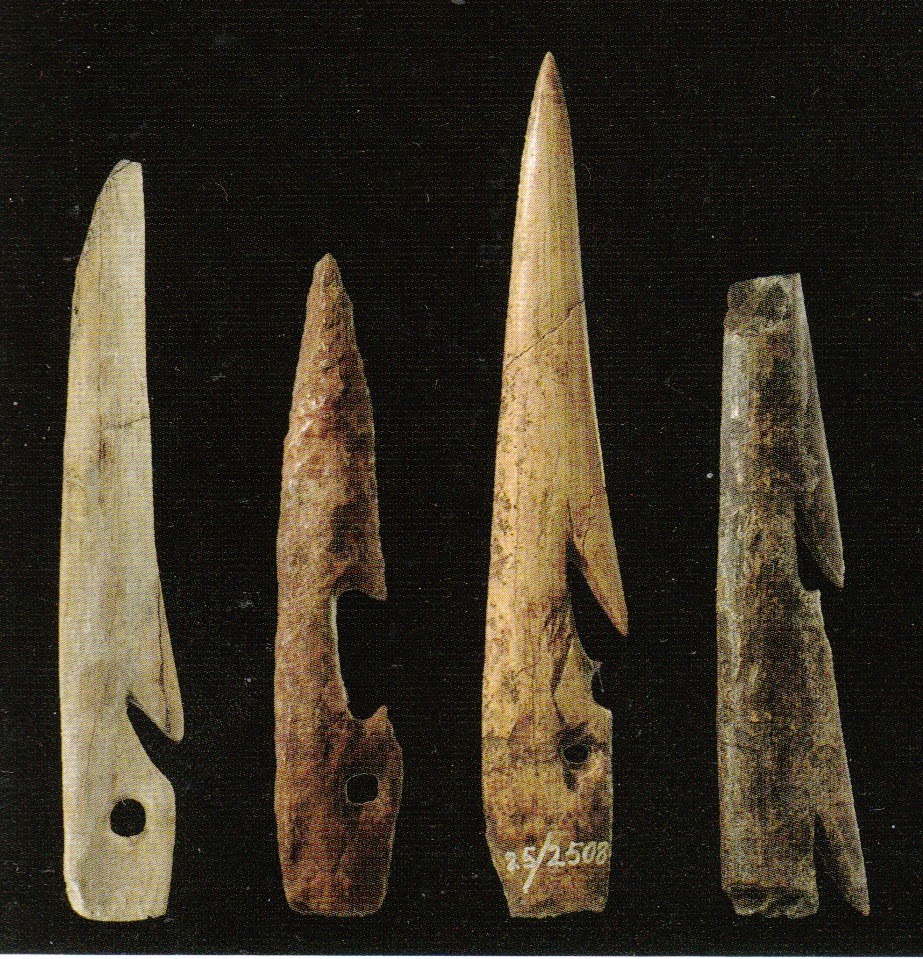Monday, January 19, 2015
The Red Paint People and Status Among Marine Hunter Gatherer Societies
The enigmatic Red Paint People are the subject of The Swordfish Hunters: The History and Ecology of an Ancient American Sea People by Bruce Bourque. Living in a sharply-defined coastal area between Maines Kennebec River and the St. John River in New Brunswick, this stone-age culture -- also known as the Moorehead Phase -- appeared mysteriously about 4,500 years ago, thrived for some 500 years, then just as mysteriously disappeared. (The name "Red Paint People" comes from their habit of adorning their numerous graves with red ochre. Bourque coined "Moorehead Phase" for the first archaeologist to describe their sites in detail.)
Judging from swordfish remains recovered from some Moorehead Phase middens, its clear that swordfish were an important food source. Swordfish are dangerous prey that can only be hunted from boats, but essentially no wood artifacts of any kind have been been recovered from Moorehead sites, and this means no boat remains. Numerous, beautifully-crafted stone adze and gouge blades have been found, however, in Red Paint cemeteries and dwelling sites, and it is most likely that the Red Paint People used dugout canoes.
Bourque discounts the possibility that they used birchbark canoes due to the absence in the archaeological record of the microplanes and stone scrapers that would have been needed to form the framework, and bone awls used to sew the bark covering. (Indeed, there is little or no evidence for bark canoes in the Northeast much before European contact.) Skin boats, too, would have been unlikely, due to their very short lifespan in the temperate climate.
Most hunter-gatherer societies have at most two forms of social distinction beyond the natural ones of age and gender: those of the shaman and the headman. But maritime hunter-gatherer societies have one additional position of power and distinction: that of boat captain. Bourques comments are of interest and Ill quote at length:
The Swordfish Hunters is a nice mix of straight archaeology, personal narrative of Bourques experience researching the topic, extrapolation of archaeological findings to broader ecological issues, and commentary on how diverse scientific disciplines can and should collaborate in uncommon ways. Normally, such a broad mixture of topics would result in an unfocused, of not confused, narrative, but Bourque pulls it off, leading from one topic to the next through smooth transitions and logical conclusions that make it an easy and thought-provoking book, especially for one that trends more toward "serious" than popular science.
Judging from swordfish remains recovered from some Moorehead Phase middens, its clear that swordfish were an important food source. Swordfish are dangerous prey that can only be hunted from boats, but essentially no wood artifacts of any kind have been been recovered from Moorehead sites, and this means no boat remains. Numerous, beautifully-crafted stone adze and gouge blades have been found, however, in Red Paint cemeteries and dwelling sites, and it is most likely that the Red Paint People used dugout canoes.
 |
| Stone adze blades from a Red Paint cemetery in Brunswick, Maine. (Click any image to enlarge.) |
 |
| Rendering showing how a stone gouge might have been hafted. Gouges would have been efficient tools with which the Red Paint People might have hollowed dugout canoes. |
 |
| Bone harpoon heads from Red Paint sites in Maine. Largest one is a bit less than 4" long. |
The power of this high-status or powerful chief emerges from hunting dangerous animals in the sea. The cause-and-effect relationship between hunting prowess and wealth is difficult to work out, but there seems to be a link between risk taking and the ability to acquire the wealth, in labor and material, needed to build a boat and maintain it and provide for its crew. On the northwest coast [of North America], for example, "only chiefs command the resources to pay for a great canoe." Among the whale-hunting Nootka of Vancouver Island, British Columbia, "[w]haling was the noblest calling, and the whaler was always a chief." And among the Tareumiut, the coastal Inupiat of northern and northwestern Alaska, senior male family heads are called umialik, meaning "umiak captain," the umiak being a large boat used to hunt whales. While umialik have no chiefly power, the title implies a degree of wealth and enhanced status. Finally, among the Alutiiq people of Kodiak Island, though they hunted from small kayaks and lacked high status, whalers were deemed too powerful and dangerous to live or be buried among normal people. These examples of high-status boat builders, boat captains, and even solitary whale hunters among societies that pursue dangerous marine prey suggest that some similar situation prevailed among the Red Paint People as well.
In many North American maritime cultures, the status of boat captains was further enhanced by the activities they alone could undertake. Thus, in addition to directing hunts, umialik used their watercraft to conduct trade and diplomacy. [Note: there is evidence that the Red Paint People conducted trade with Newfoundland, at least 400 miles away by sea.] Through gift giving and wife exchange, they competed to attract and hold onto good boat crews. Umialik can also be glossed "whaling captain." The case of the swordfish-hunting Chumash is similar in that men who could muster the support in labor to buy a plank canoe...thus attained relatively great wealth.... In sum, the hunting of dangerous marine animals tends to create status differentials of a sort rarely seen in other hunter-gatherer societies. [footnotes omitted]
 |
| Stone pendants from Red Paint cemeteries. Bourque suggests that the crescent-shaped ones (largest: 4.7" wide) might have symbolized swordfish tails. |
 |
| Slate "bayonets" from a Red Paint cemetery; longest 16". These beautifully crafted artifacts are thin and fragile and almost certainly did not serve as weapons, although they may have symbolized weapons or, as Bourque suggests, the rostrums (swords) of swordfish -- or possibly both. |
0 comments:
Post a Comment